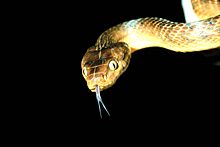OPINION: Partly Cloudy, With a Chance of Mice
Somewhere in America, a PETA activist just snapped a pencil.
The US Department of Agriculture recently announced its plan to save Hawaii (and other territories) from the threat of brown tree snakes.
Instead of relying just on cargo inspections and public service announcements, the feds are taking the fight straight to the enemy, preparing a full-scale assault on snake-central. The target? The lush, reptile-friendly jungles of Guam.
It will be a ruthless attack from the skies, with countless troops landing on hostile territory, where they will wait quietly. Very quietly.
Because they’ll all be dead.
In a scheme that seems reminiscent of Paul Thomas Anderson’s 1999 ensemble train-wreck, “Magnolia,” the US government will begin air-dropping platoons of poison-laced mice over the Pacific island sometime in the next two months.
It’s a risky-sounding proposition, given that Guam is a tourist-haven. Getting hit by a high-altitude rodent rocket doesn’t sound very awesome, after all. One has to wonder, just how bad would that hurt?
It’s time for some mouse-inspired math.
V = √2gh
The above symbols have something to do with speed. Thanks to Google, we will make absolutely no use of them.
After plugging some numbers into a handy-dandy online physics tool, we calculated the smack-factor for a 20-gram mouse dropped from a height of, say, 10,000 feet.
If you were hit while sunbathing by one of these hypothetical heroes, the impact velocity would be around 542 miles per hour.
Sounds dangerous, right? Don’t worry. We’re just trying to impress you. The government is in charge here, and as always, has a reasonable solution.
They’re giving them mice parachutes (aka cardboard strips joined with paper streamers).
The plan is to drop these little critters over the forest by hand. Don’t ask us what this person’s job title will be, but it should look just great on LinkedIn (“mouse bombardier” would be my humble guess. -Ed).
Anyhow, after a graceful descent the mice are supposed to either hit the forest floor, or have their lines caught in a tree branch. This should be just fine, states the theory, since the snakes enjoy both trees and dead things.
Of course, how tourists will feel about thousands of little decaying ornaments hanging from the canopy is anyone’s guess. Hopefully they’ll take it in stride, and keep their mouths closed when looking upwards.
Assuming the plan works, the tree snakes will quickly snarf down these tiny martyrs, and then proceed to die of a Tylenol overdose (the mice were fed acetominophen).
Not surprisingly, PETA is having a five-alarm fit over the planned massacre. Their director of cruelty investigations recently told UK newspaper The Guardian, “Brown tree snakes did not ask to be stowaways on planes or ships and then forced to survive on a foreign island.”
Of course, the alternative, planning adoption proceedings for the estimated two million snakes living on Guam might take a while.
PETA is correct about one thing though. The snakes didn’t sign up for this gig, likely having been transported to Guam decades ago by military vessels. But once they arrived, they made quick work of the island’s natural wildlife, much of which can no longer be found.
The government’s theory is that if the great mouse-drop works, Hawaii and its native species will be saved from experiencing Guam’s slithery nightmare.
Come to think of it, there’s a lot riding on these lifeless heroes.
Godspeed, little fellas. Godspeed.








